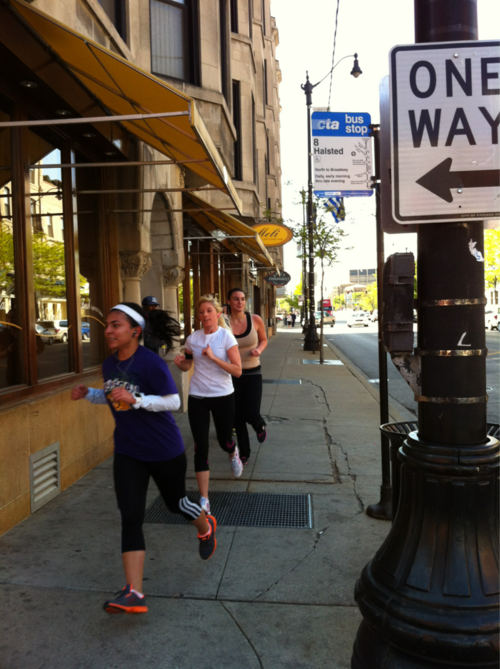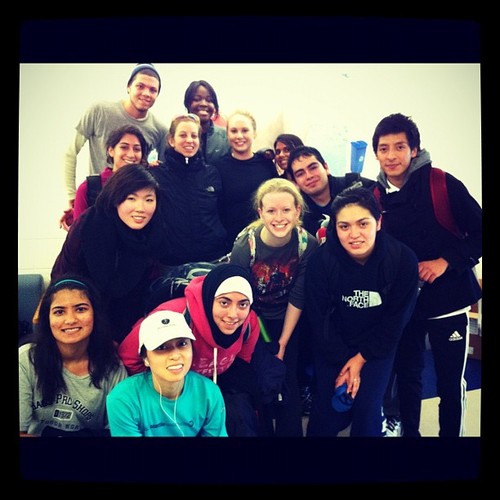A mentor of mine once said that the only difference between being a college student and being a college professor is that the professors are a chapter ahead in the textbook.
This hit close to the mark when I first got a job teaching college students how to exercise. Quite frankly, I was terrified.
Though my teaching resume was fairly substantial even at that time (nearly six years ago), the bulk of my experience was teaching ballet to pampers through pre-teens. What did I know about teaching college?!? Or exercise?!?
At first, I didn’t see a correlation between teaching kids how to dance and the world of academia, but when you’re offered a steady job with steady pay and benefits, you fake it ’til you make it.

As it turns out, those 10+ years with the littles, a group that many dance teachers would agree are the most challenging (but also most rewarding… right?), have come in exceedingly handy. The past several years spent with my 18-and-ups have allowed me to appreciate the time and experiences I had with my littles.
Teaching is teaching, regardless of age, and I’m continually surprised by the similarities between toddlers and higher ed. Littles are just small people, so you can, for the most part, teach them the same way that you would any other population.
The biggest notable difference from teaching college students is that the three-year-olds get scheduled potty breaks… otherwise, the rules are pretty much the same.
There are a couple of things that I gained from years of teaching small children that have become invaluable to me as a faculty member at the University of Illinois. In hindsight, these are qualities that not all of my colleagues possess (did I say that out loud?) and frankly sometimes I think we professors could benefit from a little face time with some littles.
The main takeaways from teaching kids, for me, were patience, self-care, thinking on my feet, and connecting with students.
1. Patience
It can be frustrating when you feel like your students aren’t “getting it”. When this happens, I practice patience and consider that it might be me who is not getting it.
Miscommunications are a challenge, not a problem, and often an indication that the instructor needs to change her approach. Consider alternative ways to give the students access to the information.
Using metaphors and analogies works at ALL ages. Now instead of pretending to be clouds and blooming flowers I compare excitation-contraction coupling to speed dating and tell them to be Kate Winslet on the Titanic when they stretch their pectoral muscles in the pool (“Jack, Jack, I’m flying!).
In marketing, writing, and speech, we follow a rule of three: if you give information in three different formats, the target audience is more likely to remember and respond to it. People learn in three different ways, and from three types of cues: visual, auditory, and kinesthetic (practice). Addressing all three learning styles helps insure that the students are on board. The rule of three can apply to repetition too. Do something three times, for three consecutive classes, or three consecutive weeks (or all of the above) and it’s more likely to stick.
2. Taking Care of My Body
There’s a reason that the majority of dance instructors who teach small children are young: it’s exhausting. The same goes for Group Fitness Instructors.
Both are somehow pegged as entry level jobs, but to do either of these jobs well takes a highly skilled, imaginative person and a boat load of stamina. No matter who your students are, teaching class after class (a typical day for me is six in a row) takes a toll on your body.
I often find myself disobeying the rules of good training by demonstrating without a proper warm-up, or always using my dominant side, or not drinking enough water. Full-out demonstrations all the time just aren’t possible when you teach six classes in a row, and it gives an unfair advantage to my earlier classes that get me while I’m “fresh”.
As time goes on and I get older (and smarter) the way that I approach teaching a class has changed, but the student experience hasn’t. My students often comment on my schedule, saying “I don’t know how you do it, Lauren!” Some days are more tiring than others, but generally I’ve worked out a way to totally exhaust the students and barely break a sweat.
My favorite master of littles, Maria Hanley Blakemore, gave some great suggestions last month on how to save your stamina, and I give my own thoughts here on the the importance of not demonstrating everything all the time (spoiler: it’s not just about YOU).
3. Thinking on My Feet
If you’ve taught before, you know that things don’t always go according to plan. Besides teaching my own students, I also teach others how to become fitness instructors.
My advice is always to plan more activities than you think you’ll need, and be prepared to throw everything out the window. Equipment goes missing, groups are unevenly numbered, someone’s got an injury you have to accommodate for, the stereo breaks….. in short, s(*$ happens.
The difference between a good teacher and a great one is how they cope and give the students a positive and seamless class even under the worst of circumstances.
4. How To Connect With Students
For littles, connecting could mean getting down on their level and playing freeze dance, or using a Dora the Explorer CD.
For me, it means Ke$Ha on the stereo and references to Spring Break in Daytona. Be it a coloring page about the circus or a Pinterest board of inspirational quotes, the point is to meet your students where they are.
Respect is mutual, and though I can come across as silly and nonchalant, it’s clear to every one of my students that I take their training seriously.
I know all 300 of their names, I ask about their lives, and invest enough in them that they know I have their backs. Because of this, they work their butts off for me. The photo of smiling, happy college students above was immediately after they ran a 5K in 42-degrees and light rain… and I didn’t hear one complaint.
Ultimately, it didn’t matter that I didn’t know anything about college students or exercise.
I figured out a few years into this that I wasn’t hired because of my extensive knowledge of step aerobics; I was hired because I have the ability to learn new things, adapt and communicate effectively.
These are qualities that transcend age and subject matter.
Occasionally, I may only be a chapter ahead in the textbook but I have many tools in my toolbox, and I learned them in front of the harshest of critics: three-year-olds and their parents.
Do you teach college students OR littles?
What have you learned from your students?
Lauren Warnecke is a freelance writer and editor, focused on dance and cultural criticism in Chicago and across the Midwest. Lauren is the dance critic for the Chicago Tribune, editor of See Chicago Dance, and founder/editor of Art Intercepts, with bylines in Chicago Magazine, Milwaukee Magazine, St. Louis Magazine and Dance Media publications, among others. Holding degrees in dance and kinesiology, Lauren is an instructor of dance and exercise science at Loyola University Chicago. Read Lauren’s posts.

